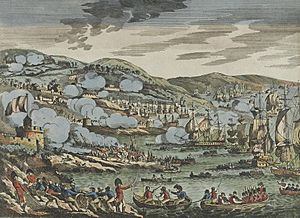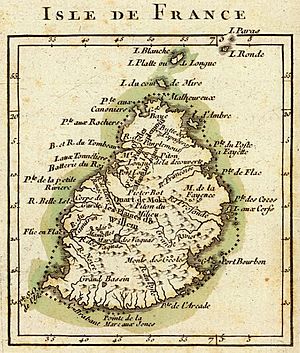Invasion of Isle de France facts for kids
Quick facts for kids Invasion of Isle de France |
|||||||||
|---|---|---|---|---|---|---|---|---|---|
| Part of the Napoleonic Wars | |||||||||
 The taking of the Isle of France, 2 December 1810 |
|||||||||
|
|||||||||
| Belligerents | |||||||||
| Commanders and leaders | |||||||||
| Strength | |||||||||
| 6,848 soldiers, sailors and Royal Marines 1 ship of the line 12 frigates 5 brigs 50 small vessels/troops transports |
1,300 regulars 10,000 militia 6 frigates 3 brigs 1 smaller vessel |
||||||||
| Casualties and losses | |||||||||
| 28 killed 94 wounded 45 missing |
Isle de France and all military stores captured | ||||||||
The Invasion of Isle de France was a big military operation by the British in November 1810. It happened during the Napoleonic Wars, a time when France and Britain were often fighting. The British Royal Navy landed a large number of soldiers on the French island colony called Isle de France, which is now known as Mauritius.
The British troops marched inland and quickly defeated the French defenders. They captured the island's capital, Port Napoleon, and the French governor, Charles Decaen, had to surrender. This victory meant that France lost its last territory in the Indian Ocean. The British also took five French warships and many cannon. After the war, Britain kept Isle de France and renamed it Mauritius. It remained part of the British Empire until 1968.
Contents
Why the British Invaded
This invasion was the final part of a two-year fight over Isle de France and a nearby island called Île Bourbon. French ships, led by Jacques Hamelin, kept attacking British trade ships in the Indian Ocean. These trade routes were very important for Britain, as they carried goods worth millions of pounds every year from India.
The British responded by sending their own ships, led by Commodore Josias Rowley. Rowley tried to stop the French ships and planned to invade the islands when he had enough soldiers. In July 1810, Rowley successfully captured Île Bonaparte and renamed it Île Bourbon.
However, things went wrong for the British in August 1810. Rowley sent most of his ships to attack the port of Grand Port on Isle de France. In the Battle of Grand Port, the British lost two ships and had two more captured. This was a big defeat.
After this loss, Rowley urgently asked for more ships and soldiers. When reinforcements arrived, the British fought more battles. In one important fight on September 18, 1810, Rowley defeated and captured the French commander Hamelin. This was a major blow to the French. With Hamelin gone and their supplies running low, the French ships on Isle de France were stuck in port. This gave the British, now led by Admiral Albemarle Bertie, a chance to prepare for a full invasion.
Planning the Attack
The British had been planning to invade Isle de France for a while. After the defeat at Grand Port, they sped up their plans. Soldiers and transport ships came from British bases in India, like Madras and Bombay. These troops were led by General John Abercromby. Naval forces, which were ships and sailors, came from the Cape of Good Hope in South Africa, led by Admiral Bertie.
All these forces met up at a small island called Rodriguez. The British commanders, Rowley and Lieutenant-Colonel Henry Keating, carefully chose where to land. They picked Grand Baie, a spot on the northwest coast, about 12 miles (19 km) north of the capital, Port Napoleon.
The plan was to send a special group of 1,555 elite soldiers first. They would storm ashore and quickly move towards the capital. They would be supported by a group of sailors trained to fight on land and Royal Marines. The main army of over 5,000 soldiers would follow. British navy ships would sail along the coast, providing help and firing their cannon if needed. The goal was to capture Port Napoleon and Governor Decaen, hoping this would make the whole island surrender.
The French governor, Decaen, knew the British were coming. He gathered about 10,000 local militia, but they were not well-trained or armed. He also tried to get prisoners of war to join his army. About 500 volunteered, many of them Irishmen who were promised French help for Irish independence. In total, Decaen had about 1,300 regular soldiers to defend the capital, led by General Edmé-Martin Vandermaesen.
The Invasion Begins
On November 22, 1810, all the British ships and troops were ready. They sailed to Grand Baie and arrived early on November 29. The first group of British soldiers landed without any fighting. Their landing boats were protected by small boats with cannon, and larger ships offshore provided even more firepower. Despite some bad weather, the first groups of soldiers and sailors were all ashore by 9:00 PM. Only two soldiers died, both from natural causes.
Lieutenant-Colonel Keating took charge of the first group and advanced towards Fort Malartic. The French soldiers there ran away and blew up the fort as they left.
On November 30, Keating's troops moved south towards the River Tombeau, which was near Port Napoleon. They had small fights with French defenders across the river. Governor Decaen himself was slightly hurt by a musket ball. The French militia guarding the bridge over the river retreated and failed to destroy it properly. This allowed Keating's troops to cross quickly and get closer to Port Napoleon. Meanwhile, the rest of the British army was landing at Grand Baie. By midday, the entire army was on the island.
On December 1, General Vandermaesen and his French troops tried to stop the British outside Port Napoleon. Keating attacked them. Some British soldiers, called sepoys from Madras, went around the French line and broke it apart. This allowed the main British attack to succeed.
With their defenses broken, the French retreated. On December 2, Governor Decaen asked for a ceasefire, which the British accepted. The next day, Decaen officially surrendered. He was allowed to keep his personal weapons and flags, and he and his soldiers would be sent back to France. Some British officers were not happy with these terms, but the commanders were glad the invasion was over before the hurricane season started. It was very important for the 70 British ships to be in a safe harbor before any big storms hit.
What Happened Next
The surrender of Isle de France was the last major British operation in this campaign. It meant that France no longer had any territory east of Africa. The island was given back its old name, Mauritius, and towns renamed by Decaen were also given back their original names.
The British captured six French warships and several smaller vessels in the harbors of Isle de France. They also took 24 merchant ships and 209 heavy cannon. Among the hundreds of prisoners released were the survivors of the Battle of Grand Port and sailors from British ships captured by the French.
Mauritius remained under British control after the war ended in 1814. It stayed part of the British Empire until it gained independence in 1968.
Even after the invasion, the Mauritius campaign wasn't quite over. News of the French victory at Grand Port had reached France, and they sent a small group of ships with supplies and reinforcements for Hamelin's squadron. This French squadron, led by Commodore François Roquebert, left France in February 1811. However, by the time they reached the Indian Ocean, Isle de France was already in British hands. Roquebert tried to sail back to France but was chased by British ships from Mauritius. His squadron was captured in a battle on May 20, 1811, and only one French ship escaped.
Images for kids





